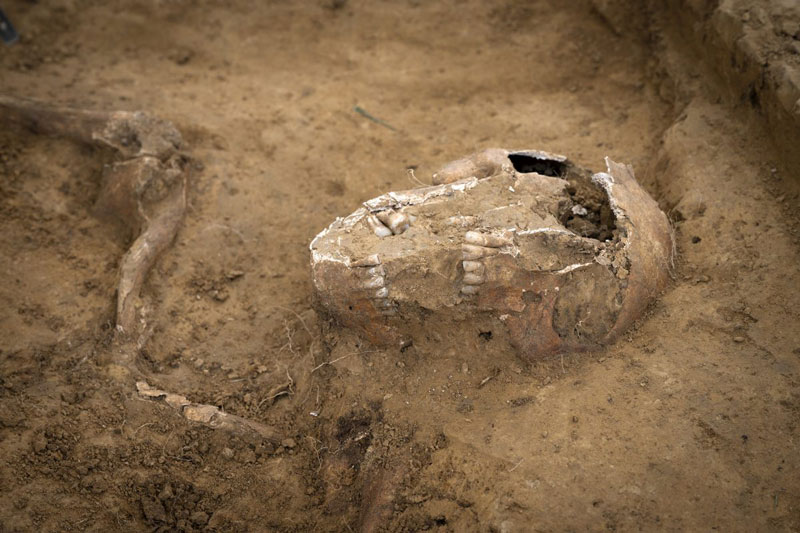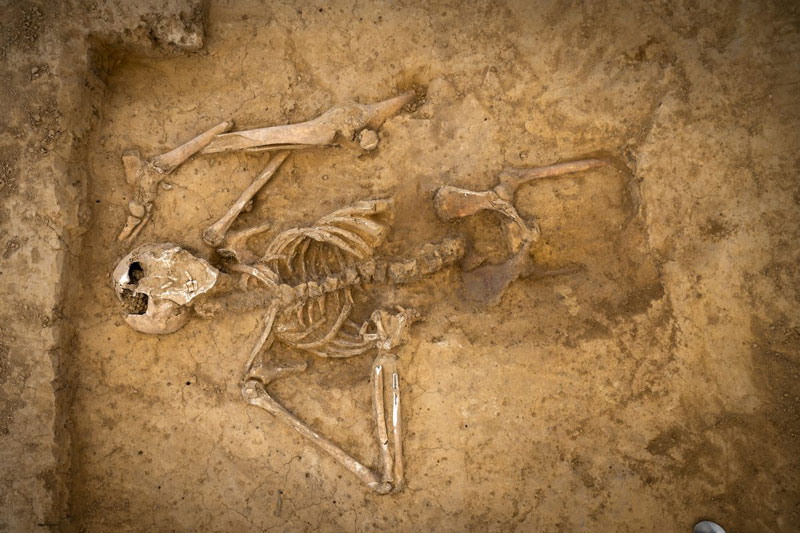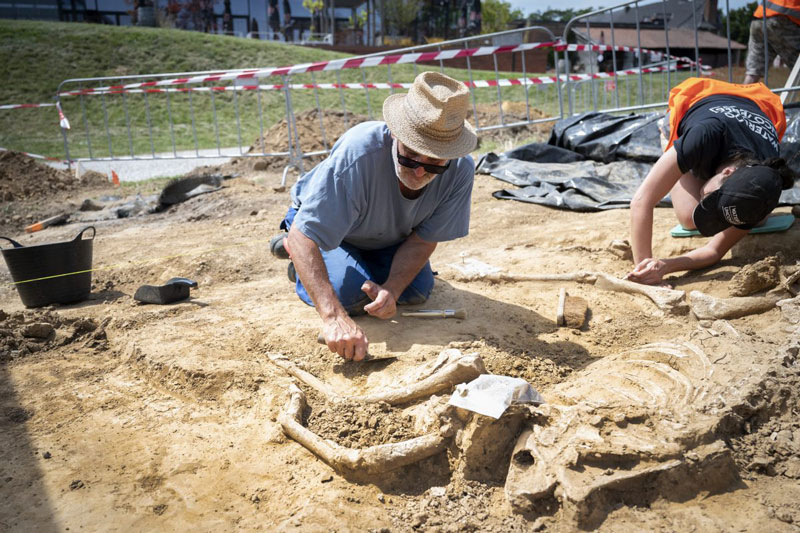
Archeologists working alongside military veterans uncovered the remains of a soldier killed at the 1815 Battle of Waterloo. [waterloouncovered.com]
The complete skeleton was discovered in a former gully alongside the remnants of ammunition boxes, medical waste and amputated limbs.
It was adjacent to the site where a field hospital operated during the one-day battle in which a coalition led by the Duke of Wellington defeated Napoleon’s army and put the Frenchman’s aspirations of empire to rest.
“I’ve been a battlefield archeologist for 20 years and have never seen anything like it,” said Tony Pollard, a project director and head of Glasgow University’s Centre for Battlefield Archaeology in Scotland.
“We won’t get any closer to the harsh reality of Waterloo than this.”
As many as 20,000 men fell on June 18, 1815, during the epic confrontation near Brussels. Yet what happened to their remains has been a mystery for two centuries.
Many of the dead are thought to have been incinerated on pyres, while others were shipped to Britain as part of a gruesome trade in fertilizer made from human bones. Others would likely have been piled into yet-undiscovered mass graves in efforts to clear a battlefield strewn with thousands of bodies.

The remains—an incongruously rare find at one of history’s most notorious battlegrounds—were found near a field hospital. Up to 20,000 soldiers were killed in a single day at the site of Napoleon’s defeat, but few of their remains have ever been uncovered. [waterloouncovered.com]
The continuing project is run by Waterloo Uncovered, a U.K.-based charity that brings world-class archeologists together with veterans and serving soldiers. Working with some of Europe’s top universities, the organization “aims to understand war and its impact on people—and to educate the public about it.”
“Finding human remains can invoke a range of strong emotions, from excitement at their discovery to understandable sadness and reverence.”
The dig has uncovered a wealth of archeological treasures over seven seasons, among them the bones of some of the 7,000 cavalry and other horses killed during the battle, along with more than 6,000 artifacts, including:
• “huge numbers” of musket balls and grape shot, attesting to the vicious assaults on the walled farm compound of Château d’Hougoumont, epicentre of the fighting;
• the remains of destroyed buildings, allowing archeologists and historians to revise their understanding of Hougoumont’s layout, and why the French failed to take it;
• personal items, including uniform buttons from both Coldstream and Scots Guards, showing how units merged in a desperate defence of the chateau’s north gate;
• evidence of a firefight around the hospital at Mont-Saint-Jean, well to the rear of the main allied position, probably the result of a breakthrough by French cavalry;
• French artillery rounds from the point in the battle where Napoleon’s forces came closest to victory, and a large, unexploded howitzer shell from their bombardment of the ridge sheltering the allied infantry line;
• and the rediscovery of the remains of the “lost” chateau of Frichermont on the left of Wellington’s line; held by the Dutch during the battle, the site had been lost to view for decades.
Most poignant, though, has been the grim evidence of the battlefield surgeons’ handiwork—the amputated limbs of wounded men, some with catastrophic injuries, others peppered with lead balls.

Archeologist Dominique Bosquet carefully exposes the remains of one of the 7,000 horses killed during the battle. [waterloouncovered.com]
“Finding human remains can invoke a range of strong emotions, from excitement at their discovery to understandable sadness and reverence, as this is likely to be a soldier, just as those excavating it with Waterloo Uncovered are,” said veteran Rod Eldridge, a lead welfare officer on the project. “There are strong feelings amongst the team that the bones must be treated with respect and dignity at all times.”
Before the 2022 dig wrapped up on July 15, Waterloo Uncovered conducted the first ever large-scale geophysical survey of the Waterloo battlefield. Led by PhD candidate Duncan Williams, the survey aims to identify anomalies in the landscape that might indicate mass graves, large masses of metal or lost structures.
Arguably history’s most famous battle, Waterloo was, well, Napoleon’s Waterloo.
Fought in what was then the Netherlands, now Belgium, Waterloo pitted some 72,000 French troops under Napoleon’s command against two allied armies: a British-led coalition under the Duke of Wellington and a Prussian army headed by Field Marshal Gebhard Leberecht von Blücher—all told, about 120,000 men.
The allied victory brought to an end the Napoleonic Wars—12 years of conquest and struggle spanning Europe and North America; the Atlantic, Pacific and Indian oceans; the North and Mediterranean seas; French Guyana, the West Indies, Southern Africa, Java and the Middle East.
At the Mont-Saint-Jean escarpment across the Brussels Road, near the village of Waterloo, Wellington withstood repeated French attacks throughout the afternoon of June 18, aided by incoming Prussians attacking the French flank.
As evening settled, Napoleon assaulted the Anglo-allied line with his last reserves, the senior infantry battalions of the Imperial Guard. The Prussians broke through the French right flank while the Anglo-allied army repulsed the Guard.
The French army was routed.
Arguably history’s most famous battle, Waterloo was, well, Napoleon’s Waterloo. Wellington described it as “the nearest-run thing you ever saw in your life.”
Napoleon abdicated four days later, ending his rule as Emperor of the French. Coalition forces entered Paris on July 7.
“Some of our team on Waterloo Uncovered have had first-hand experience of close-quarter fighting in walled compounds in Iraq or Afghanistan—very like the layout of Hougoumont.”
Now, the battlefield where great carnage was wrought is a place of mindfulness and healing.
A veterans’ well-being and support program is central to the Waterloo Uncovered mission. Working with related welfare charities and regiments themselves, a diverse group of new participants from a mix of service backgrounds are selected each year to embark on a 12-month program focusing on recovery, well-being, transition to civilian life, education and employment.
A team of experienced, professional support staff work with participants identifying personal goals, monitoring progress, providing support and evaluating outcomes.
The National Army Museum and the British Museum conduct tours, handle finds and provide historical context. The dig each July is the program’s highlight.
“Once there,” says a Waterloo Uncovered summary, “the experience of being reintroduced to a familiar service background, the chance to learn new skills in a very hands-on manner, the methodical, almost meditative nature of detailed archaeological work and the personalized support on offer can be life-changing for many participants, helping them to come to terms with difficult episodes from their past.”
More than 100 serving and veteran participants have taken part in the program since it was launched in 2015.
“Five days after my 18th birthday, I was deployed to Iraq,” said participant Ashely Gordon, a 1st Rifles veteran. “I returned … and very shortly after I experienced a lot of problems with PTSD.
“I’ve enjoyed the intricate troweling. You’re so focused that you don’t think about absolutely anything else, just what you’re doing in that moment, which I find really therapeutic.”
It’s not just the veterans who benefit from working with the archeologists. The archeologists often see their work in another light while working alongside the veterans.
“There’s the extra dimension of working with veterans,” said Pollard. “It’s brilliant to share a laugh and see the benefit people in the team are getting. But for me as an archeologist there’s more.
“Some of our team on Waterloo Uncovered have had first-hand experience of close-quarter fighting in walled compounds in Iraq or Afghanistan—very like the layout of Hougoumont, for example. You can be kneeling next to them in a trench and they’ll notice something that you haven’t, and you’ll think: ‘Yes, you’re right!’
“That’s a uniquely valuable perspective for an archeologist to have.”
—
For more on Waterloo Uncovered, visit the website at https://waterloouncovered.com.
Advertisement


















